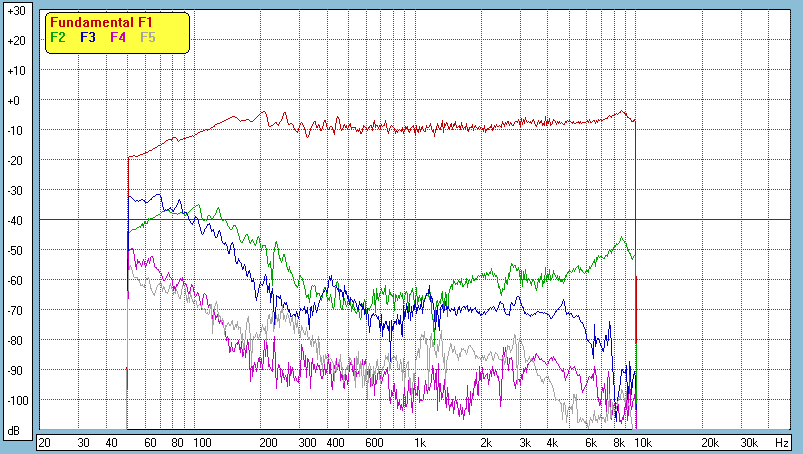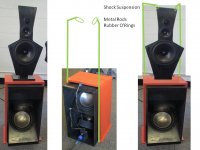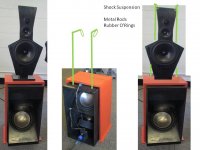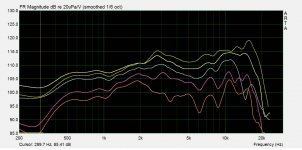And others will argue that it makes no never mind, a simple rectangle is quite "good enough" thank you. Ain't life grand . . .I made the same conclusion, I can use the LX521 baffle shape and pretend that it's better than a simple rectangle.
I'm still wondering about vertical polar, the effect of the bottom profile (and gap), roundover or no roundover, chamfer or no chamfer, star or angel, should any ornaments be blue . . .
Yes, there are quite a number of 4"ish drivers that look pretty competent from 500 to 5000 Hz. . . . I have to wonder if it's not just another "pick your poison and pretend to taste a difference" sort of thing. I find that active crossover washes out a lot of what-otherwise-might-be-significant driver differences . . .10f, 12M, tc9, all good, right?
I mean, there may be more variation in the midrange choice, than the baffle particulars..
Yes, there are quite a number of 4"ish drivers that look pretty competent from 500 to 5000 Hz. . . . I have to wonder if it's not just another "pick your poison and pretend to taste a difference" sort of thing. I find that active crossover washes out a lot of what-otherwise-might-be-significant driver differences . . .
YUP!!!
A couple of things to consider about the upper midrange. It's not just size. It's the directional characteristics and also the effect of the blockage on the back side. The 10 is very nice since it is a neo magnet which is very small. As I said before, I tested a number of different drivers and was not satisfied with any of them. Then the 10F came out and I was pleased at its performance.
Also, I would like to point out something about those ARTA plots. They don't really say much about the consistence of the directional characteristics unless the plots are normalized by the axial response. For example, I could easily measure the response of any system at 60 degrees off axis and equalize that response to be perfectly flat at -X db and the ARTA type plots would look excellent except the on axis response might show dips and peaks. On the other hand, if the response is normalized by the axial response, the of axis contours truly reflect at what angle the response is down X, Y or Z dB vs frequency, relative to the axial response. That is why the plots I present are always normalized but the axial response. It gives a true indication of the polar response.
Also, I would like to point out something about those ARTA plots. They don't really say much about the consistence of the directional characteristics unless the plots are normalized by the axial response. For example, I could easily measure the response of any system at 60 degrees off axis and equalize that response to be perfectly flat at -X db and the ARTA type plots would look excellent except the on axis response might show dips and peaks. On the other hand, if the response is normalized by the axial response, the of axis contours truly reflect at what angle the response is down X, Y or Z dB vs frequency, relative to the axial response. That is why the plots I present are always normalized but the axial response. It gives a true indication of the polar response.
A couple of things to consider about the upper midrange. It's not just size. It's the directional characteristics and also the effect of the blockage on the back side. The 10 is very nice since it is a neo magnet which is very small. As I said before, I tested a number of different drivers and was not satisfied with any of them. Then the 10F came out and I was pleased at its performance.
Great! you could have said that before in stead of being dismissive.
Now we all learned something new today!

That's . . . interesting . . . because from the drawings the Scan 10F, the Seas FU10 and the Vifa TG9 show similar (if not all but identical) rear profiles, despite the neo magnet in the 10F (if anything it's several of the small Tang Band drivers that appear more "open" in the rear). I don't see the difference in pictures either . . . perhaps they would appear different side by side face down on the bench.A couple of things to consider about the upper midrange. It's not just size. It's the directional characteristics and also the effect of the blockage on the back side. The 10 is very nice since it is a neo magnet which is very small.
Great! you could have said that before in stead of being dismissive.
Now we all learned something new today!

Sorry if you were offended by my curt reply. But "The vifa tc9 is 1/10th the price and a better performer" was not very informative either since it gave no indication as to why it might be considered a better performer.
Also, Deward brought up burst tests. I got into a discussion of this many years ago in that they are pretty useless tests of a raw driver. What matters is how the driver/filter combination respond. Burst response shows linear distortion which can be corrected. Linear distortion is nothing more than a deviation from a desired target. If the target is, for example a band pass response, that band pass, under ideal conditions, will have a specific burst response. Shape any driver's raw response to that target and the burst response will match the target's burst response. Any deviation form it will be the result of nonlinear distortion, or an imperfect match to the target. You can see what I did here.
Sorry if you were offended by my curt reply. But "The vifa tc9 is 1/10th the price and a better performer" was not very informative either since it gave no indication as to why it might be considered a better performer.
Well, it's not a ridiculous statement that I made.
I believe that even though the vifa has a higher Q, the HD is comparable to the SS.
Vifa Tc9

SS 10f

Well, it's not a ridiculous statement that I made.
I believe that even though the vifa has a higher Q, the HD is comparable to the SS.
Vifa Tc9

SS 10f

Well, now that you present your data there are some legs to stand on. Much appreciated. I don't see better though. Distortion is similar for F2, the 10F appears better for F3 and F4 and F5 are pretty much inconsequential. But going back to the sensitivity issue, while Deward has made the point that it can be compensated for in the crossover, the 5dB difference still means to achieve the same SPL a more powerful amplifier is required.
Now, if you look at the published frequency response for the 10F, the TC9 and the Seas FU10 you wil see that both the Seas and the Vifa have a bit of a rough spot between 1 and 1.5k, and at 60 degrees off axis the 10F rolls off at higher frequencies much smoother.
Also, please recall that when I made the choice of the 10F I was designing the original Note with passive crossover for the panel and sensitivity was a big issue. I certainly was not going to design a speaker of this type to have a nominal sensitivity of 85dB/2.83V/M. There really weren't a lot of choices back then and all the other drivers I looked at were in the 85 to 87dB and and a couple I tested just didn't measure well at all when moving off axis. Plus, I really didn't want to use an "off" brand. The original Note would not have come to realization if the 10F had not appeared on the market. Based on its performance to date I see no reason the make a switch. The cost of the Note has been significantly reduced with the Note II and if I splurged a little on the best upper mid available I can live with that.
That's pretty much irrevelant, because you're off both of them well above the frequency where driver "Q" matters. The distortion profiles, while different, are both admirably (and probably inaudably) low (and the different cone of the TG9 gives a different, also low, profile from the TC9). The drivers are remarkably similar in a number of ways (price excepted) . . . I'd hate to have to try to tell them apart in a "blind" test (behind active crossovers in otherwise identical speakers).even though the vifa has a higher Q,
That's not to say that the Scan 10F is not a very good driver . . . it's just to say that by accident, or by luck, or by good design the Vifa (especially the TG9 version) is also a very good driver (making it a real bargain).
If you're selling a "high end" speaker (or "high end" design) the Scan name alone is probably worth the extra bucks . . . it's more pain than it's worth trying to explain why you used a "cheap TV driver".
Ps. It looks like John typed a bit faster than me this time . . .
Last edited:
That certainly makes a difference, although it pretty much goes away when you go full active. The sensitivity of the TG9 (4 ohm) is 87 dB at 2.8V, the 10F (4 ohm) is 90 dB at 2.8V (both nominal . . . I have not measured the two side by side on the bench). That's significant in a "passive" design, not so much when active. With the same cone area and the same (nominal) xmax they are both going to make effectively the same amount of noise (plenty loud enough) in use.Also, please recall that when I made the choice of the 10F I was designing the original Note with passive crossover for the panel and sensitivity was a big issue.
That's pretty much irrevelant, because you're off both of them well above the frequency where driver "Q" matters. The distortion profiles, while different, are both admirably (and probably inaudably) low (and the different cone of the TG9 gives a different, also low, profile from the TC9). The drivers are remarkably similar in a number of ways (price excepted) . . . I'd hate to have to try to tell them apart in a "blind" test (behind active crossovers in otherwise identical speakers).
That's not to say that the Scan 10F is not a very good driver . . . it's just to say that by accident, or by luck, or by good design the Vifa (especially the TG9 version) is also a very good driver (making it a real bargain).
If you're selling a "high end" speaker (or "high end" design) the Scan name alone is probably worth the extra bucks . . . it's more pain than it's worth trying to explain why you used a "cheap TV driver".
Ps. It looks like John typed a bit faster than me this time . . .
Yes, I know the drivers are not being used at that low frequency, but the tc9 can take more abuse whilst keeping low distortion and that is important in an OB.
I agree the SS is a great driver, and when I first saw Zaph measurements...I was sure to buy it. Thank god I waited a while because he then posted the vifa measurements. I bought 52 of them.
I know name brands are important in the big leagues, but for a flat pack DIY, I would rather save 200 bucks!
I wouldn't bet on that . . . although they have almost the same nominal xmax (without either defining exactly what that means) the Scan has a much larger xmech . . . you'd have to really work to break it. But I wouldn't plan on driving either of them to xmax anyway if keeping distortion low is part of the plan . . .but the tc9 can take more abuse whilst keeping low distortion
My lunch table survey generated positive comments for the LX521 top baffle artistic Grecian Urn shape, EXCEPT for the funky base stand. A few stand-offs at the baffle corners would allow a form fitting lycra sock grill cloth.
Shock mounted swing baffles had positive threads. A top rubber O'ring suspension mounting would be interesting to preview at a Burning Amp meeting.
Shock mounted swing baffles had positive threads. A top rubber O'ring suspension mounting would be interesting to preview at a Burning Amp meeting.
Attachments
Last edited:
Not to keep with the OT but I tried the Vifa TC9 as an upper mid in my 4-way dipoles for a bit. If anyone is interested I'll see if I can dig up the graphs. I was shooting for a 4k+ upper xo to the tweeter. The TC9 directivity started narrowing more than I would have liked past 2.5k, compared to the Fountek FR88, or better yet the Neo8's I ended up with. The little Vifa did not match up well with the tweeter at 4k+ at all as far as dispersion is concerned.
Yes, the TC9, with it's 2.7" diameter cone, is starting to beam at 2.5kHz . . . as are all the 3" to 4" drivers, though not enough to be a show stopper for me. The trouble with the Neo8 is that to get slightly better horizontal axis performance you have to accept much worse vertical axis performance, along with some other issues unique to the Neo8. If you like it you like it, and nothing wrong with that, but many designers have looked at it and concluded that overall there are better choices. I really wanted to like it, but couldn't . . .The TC9 directivity started narrowing more than I would have liked past 2.5k,
I agree that the bass box really needs a grill cloth . . . it will be very easy to add.EXCEPT for the funky base stand.
Not to keep with the OT but I tried the Vifa TC9 as an upper mid in my 4-way dipoles for a bit. If anyone is interested I'll see if I can dig up the graphs. I was shooting for a 4k+ upper xo to the tweeter. The TC9 directivity started narrowing more than I would have liked past 2.5k, compared to the Fountek FR88, or better yet the Neo8's I ended up with. The little Vifa did not match up well with the tweeter at 4k+ at all as far as dispersion is concerned.
Yes. I would like to see the off axis graphs. do you have them up to 45 degrees?
I'm using these drivers in a line array, this would be helpful
Thank you
Its getting a bit of an old topic here, but anyway here it goes:
In top of the baffle the back tweeter is mounted above the front one. I always thought its crucial to mount the dipole tweeters in the same axis. When mounted higher, vertical off axis response at 90 degrees gets all messed up resulting in a bouncing up and down response straight at floor and ceiling (90 degrees top and bottom). Doesn't effect horizontal off axis behaviour offcourse BUT dont we want a nice dipole effect to eliminate unwanted reflections from floor/ceiling in a nice even spread way?
Is this effect not relevant because the tweeter is just doing >7k or has it to do with the special shaped baffle? Or am I just thinking wrong/missing something?
In top of the baffle the back tweeter is mounted above the front one. I always thought its crucial to mount the dipole tweeters in the same axis. When mounted higher, vertical off axis response at 90 degrees gets all messed up resulting in a bouncing up and down response straight at floor and ceiling (90 degrees top and bottom). Doesn't effect horizontal off axis behaviour offcourse BUT dont we want a nice dipole effect to eliminate unwanted reflections from floor/ceiling in a nice even spread way?
Is this effect not relevant because the tweeter is just doing >7k or has it to do with the special shaped baffle? Or am I just thinking wrong/missing something?
- Status
- This old topic is closed. If you want to reopen this topic, contact a moderator using the "Report Post" button.
- Home
- Loudspeakers
- Multi-Way
- LX521, the baffle


